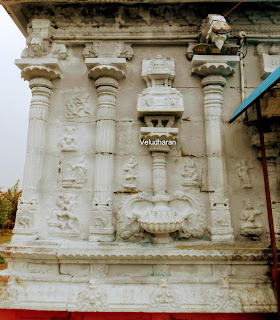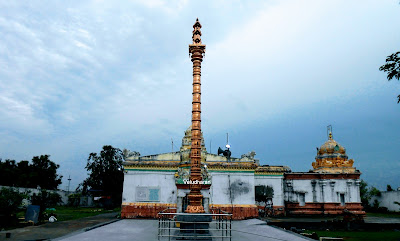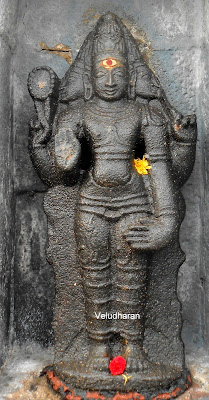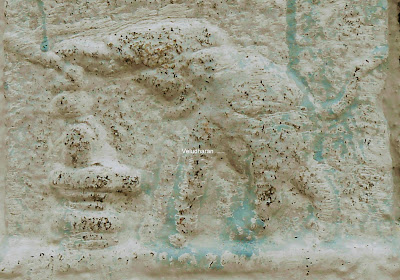It was planned to visit 4 Shiva Temples and an Amman temple of OMR ( Old Mahabalipuram Road ) Thaiyur, near Kelambakkam on 21st July 2021, of which Sri Azhakeeswarar temple was kept closed during my Visit. This place was called as “Thaikaja Muruganoor” ( Thaikajam – means Sand stone in Sanskrit ), since Lord Muruga was made of Sand Stone, which has got corrupted to the present name of Thaiyur. It was learnt that there were 7 Shiva Temples in this Village Thaiyur of which 3 are not exists now. This Murugeeswarar temple is on the west side of the Village. Consort : Sri Maragathavalli
Some of the salient features of this temple are…..The temple is facing east with a Mandapam and Temple tank is on the back side / west side of the temple. One the Mandapam pillar has the bas –relief of Murugan keeping his leg on his vahana peacock and Vinayagar is on the left side wall. Stucco images of Lord Shiva and Parvati as Rishabaroodar, Vinayagar and Murugan are on the top of the Mandapam. Dwajasthambam ( installed in the year 2021 ), Balipeedam and Nandi are after the entrance mandapam. Moolavar in the Sanctum sanctorum is with Ambal Piriyavidai Nayagi. In koshtam, Vinayagar, Dakshinamurthy, Maha Vishnu and Durgai.
In prakaram Vinayagar and Chandikeswarar. Construction of Navagraha sannidhi is in progress. In Maha mandapam Ambal Maragathavalli is facing South, Nagars, Vinayagar, Subramaniyar, Parasakthi, Kala Bhairavar, Chandran and Suriyan. In Artha Mandapam Sri Valli Devasena Subramaniar ( Made of Sand stone found disfigured due to age and abhishekams – devotees believes that Murugan is of swayambhu ) with Peacock in front, Kasi Viswanathar, Chandikeswarar in worshiping posture, Urumetru Vinayagar holding Mazhu and Thandam ( inscription is on the base, as per experts this Vinayagar belongs to 9th Century ), Shanmugar sitting on Peacock and Utsava murtis. Bala Vinayagar and Balamurugan are at the entrance of sanctum sanctorum. There is no Dwarapalakas.
ARCHITECTUREThe Temple complex consists of Sanctum Sanctorum, antarala, artha mandapam and maha mandapam. Originally Ambal Temple was built separately with sanctum Sanctorum, antarala and Artha mandapam. The main shrine mukha mandapam was joined with Ambal temple which forms as Ardha mandapa from Main Shrine and Maha mandapa for the temple. The original temple was reconstructed as stone temple during Vijayanagara Period. The Ambal temple built during Chozha / Pandya period was not touched.
The main sanctum sanctorum adhisthana is of Kapothabandha adhisthana with virutha Kumuda. Lotus petesdal is on the jagathi. The Wall portions has the Kumbha panjaram and Koshtapancharam. The wall has the Bas reliefs of Chandran, Suriyan, Brahma, Krishna, Mahishasuramardini, Ambal worshiping Lord Shiva, Kanchipuram Ekambareswarar temple sthala purana, Viyagrapatha Worships Lord Shiva, Rishabaroodar, Pichadanar, etc. The bas-relief has the full story of Arjuna’s penance on Lord Shiva to get the pasupata astra, Lord Shiva came as Hunter / Kiratha, both shots a pig, Fight between Lord Shiva and finally Lord Shiva and Parvati as Rishabaroodar blesses Arjuna.
In the Valabi, the Vijayanagara period Pothiyals instead of madalai or Bhuta Ganas. The kapotha nasikoods has the images of Vinayagar, Mahisasuramardini, Narasimhar, Ambal, Pichadanar, Elephant worships Lord Shiva, Vyaghrapada worships Lord Shiva, Bairavar, Murugan, Ashtadikpalakas, Monkey, etc.
A 3 tier Dravida vimana is on the Bhoomi desam above the Viyyalavari. Stucco images of Lord Shiva with Parvati, Dakshinamurthy, Maha Vishnu and Brahma are on the stucco / brick Vimana. HISTORY AND INSCRIPTIONSAs per Jatavarman Sundara Pandyan period inscription Lord Shiva was called as “Azhakiya Chokkanar” and Vijayanagar period as “Murugeeswarar”. ( Azhakan – Murugan, Chokkanar – Eswarar ). This place was in Amoor kottam, Komuzhi nadu and was called as Sthala Sayanapuram and Rajakesari Nallur during Rajarajan-I’s, period ( Thiruvidanthai Temple inscriptions ) and “Ayiramvelipatru” during 15th Century, Vijayanagara Period.
As per Dr. S Ramachandran, Epigraphist of Tami Nadu Archaeology Department , based on the architecture the present temple belong belongs to 13th Century ( some of the experts opinion is 14th to 15th Century Vijayanagara Period ), Chandikeswarar and Vinayagar idols belongs to 9th to 10 Century. Hence the original temple might be existed before 09th Century as brick temple, ( may be constructed by Pallavas ) and reconstructed as stone temple during Vijayanagara’s period. Since the Ambal temple was constructed as a stone temple initially, no reconstruction was not done latter.
Sadaya Varman Sundara Pandian’s 19th reign year ( 13th Century ) inscription of Ambal Temple Thiripatta kumuda, records that “Nayanar Azhagiya Chokkanar” was established by 6 persons and they are Mullikudayan Kolavarha Mudaliya Periya Perumal, Thiruvekambamudayan, Kaariyazhwan, Devanayagan and Varamtharum Perumal. For the same they had given a gift as per the request of Thevar Swamithevar, the Kani land at Chemmugampakkam as Thirunamathukani.
Another inscription traced from the Urchavar’s platform in Mukha mandapa belongs to Vijayanagara King Achutha Devaraya’s period. It mentions as Saka year 1458 ( 1536 CE ) Bramathi Samvathsara. Lord Shiva was mentioned as Amoor kottam Kumizhi naatu Ayiramvelipatru Sri Rajakesari Nallur alias Thaiyur Nayanar “Thirumurugeesvaramudaya Nayanar”. From this inscription it is understood that the present name of Lord Shiva, is since Vijayanagara period. This inscription records that Ayyapillai ‘s son Thirthar Pillai of Puzhal Kottam Soundarya Chozhapuram Abasthamba Soothiram Kashba Kothra, gifted Kundranallur Kundru ( may be a small Hill ), situated at Amoor Kottam 2000 veli land in Nayakatha and Dakshina Seermai as manyam to this temple.
Another inscription of 16th Century ( Krodhana year Aadi month 31st day ) inscription records the name of the King as Maha mandaleswaran … Immadi Thorathara ( Va) Vijaya Kumara Thiruvaladeva maharaja, gave a Dharmasathanam. ( the King may be Vijayanagara King Thirumalaideva Maharaja ) and may be inscribed in 1565 CE. In this Lord Shiva was mentioned as “Thirumugeeswaramudaya Thambiranar”. This inscription records that a rent ( சோடி ) was collected from the Villages belongs to this temple. In front of Seermaiyar and Iratti Appar, the King changed as sarvamanya Viyavastha instead of rent at this temple. This means that the temple lands were converted to sarvamanya lands instead of Manya lands.
The One line inscription on the pedestal of Vinayagar reads as “Sri Urumetru – ஸ்ரீ உருமேற்று”. Exactly what this means is not known and needs to be explored further. Dr. S Ramachandran is of the opinion that this Vinayagar idol may belongs to 9th to 10th Century Abarajithan or Kambavarman period. and may denote Pallava Kings titles like “Pakapidugu” ( pidugu – Thunder ) or it represents the name of Vinayaga is not Known.
The Legend behind the Urumetru Vinayagar is… The word Urumeru means IdiyeeRu – இடியேறு, ie Thunder. This may be compared with the titles of Pallava Kings as “Mahapidugu” in that Pidugu means Thunder. This Vinayagar may belongs to Pallava Kings Aparajithan, Kambavarman. Whether this statement may applicable or not to this Vinayagar and whether it represents this Vinayagar has to be explored further. This sort of Thunder with Lightning used to happen in west Bengal on new Year Day. This Thunder Lightning will be in the shape of Vinayagar’s face, hence this is being called as “Hasthikara” and worshiped as “Khanbaisagi”. Whether this is related to the Vinayagar worship and Bengal’s worshiping Culture has to be explored further to get the meaning of “Urumetru”.
It is believed that this temple is a Parihara sthalam for Rahu, Ketu doshas, Pillai Peru dosha, to get relieved from the chronic deceases, Child boon, to get relieved from the marriage obstacles, etc,. POOJAS AND CELEBRATIONS Apart from Regular Poojas, special poojas are conducted on Pradosham, Maha Shivaratri, Theipirai Ashtami, Sankatahara Chaturthi, Krithigai, Arudra Darshan in the month Margazhi and Annabhishekam in the month Aippasi. Special abhishekam will be conducted to Lord Muruga on Karthigai Deepam, Thiruvathirai, Thaipoosam. Murugan's Thirukalyanam will also be conducted on Vaikasi Visakam day in a grand manner.
TEMPLE TIMINGSThe temple will be kept opened between 07.30 Hrs to 09.30 Hrs and 18.00 hrs to 20.00 hrs.
CONTACT DETAILS.Mr. Uma Mahesh may be contacted on his mobile number +91 9940126814, for further details on this temple.
HOW TO REACHThis temple is on the West side of the Village Thaiyur.The temple is about 2 KM from Sri Chenganmaaleeswarar Temple on Old Mahabalipuram Road. From Kelambakkam to Thiruporur, the road immediately after the Sri Chenganmaaleeswarar temple leads to this Village Thaiyur.City buses are available from Tambaram ( 55 K ) and T. Nagar.The temple is 5.1 KM from Kelambakkam, 8.7 KM from Thiruporur Murugan Temple, 27 KM from Mahabalipuram & Vandalur, 40 KM from Chennai central.Nearest Railway Station is Vandalur.
LOCATION OF THE TEMPLE: CLICK HERE
Ref: 1. Kalvettu -65, Magazine 2. VideosThanks to Mr Uma Mahesh for providing me the above details and some photos. Arjuna's Penance - Arjuna and Lord Shiva fights with each other for the pigArjuna being blessed by Lord Shiva and Parvati Vyaghrapada worships Lord Shiva Patanjali in the form of Snake worships Lord Shiva Elephant worships Lord Shiva ( Kalahasti Temple Sthala purana )Cow worships Lord ShivaKanchipuram Kamakshi Amman & Ekambareswarar Temple Sthala purana
Kannappa NayanarKaraikal Ammaiyar
KinnarasLord Shiva with ParvatiMahishasuramardini
Monkeys on the Kumbha panjaram kodi karukku
PichadanarListening to Dakshinamurthy a relief on the side of Dakshinamurthy
Lakshmi NarasimharPothyal in the valabiJatavaraman Sundarapandyan's period period inscriptions--- OM SHIVAYA NAMA ---
POOJAS AND CELEBRATIONS
Thanks to Mr Uma Mahesh for providing me the above details and some photos.
Arjuna's Penance - Arjuna and Lord Shiva fights with each other for the pig
Arjuna being blessed by Lord Shiva and Parvati
Vyaghrapada worships Lord Shiva
Patanjali in the form of Snake worships Lord Shiva
Cow worships Lord Shiva
Kanchipuram Kamakshi Amman & Ekambareswarar Temple Sthala purana Kannappa Nayanar
Karaikal Ammaiyar
Kinnaras
Lord Shiva with Parvati
Mahishasuramardini
Monkeys on the Kumbha panjaram kodi karukku
Pichadanar
Listening to Dakshinamurthy a relief on the side of Dakshinamurthy
Lakshmi Narasimhar
Pothyal in the valabi
Jatavaraman Sundarapandyan's period period inscriptions











































No comments:
Post a Comment